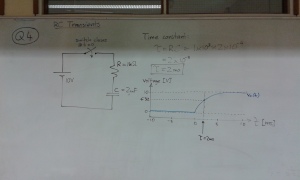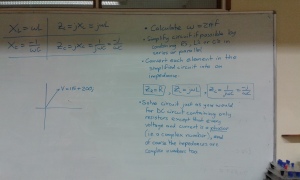The following are the numerical answers to the questions on the 7-5-2015 tutorial sheet.
I wrote a MATLAB/Octave script to check my answers. In case you want to take a look at it (for example if you’re trying to work out why one of my answers is different from yours), you can download it here.
Q1.
The time constant τ = 0.1 s
Q2.
The time constant τ = 0.0001 s = 100 μs
Q3.
The time constant τ = 0.001 s = 1 ms
Q4.
vC(0.002) = 6.32 V.
Q5.
The time constant τ = 1 s.
vC(τ) = 4.4146 V.
Q6.
- 2 true nodes
- 1 binary nodes
- 3 branches
- Vs and R1 are in series
- R2 and R3 are in parallel
Q7.
- 4 true nodes
- 3 binary nodes
- 6 branches
- V2, V1 and R1 are in series
- R4 and R6 are in series
- No elements are in parallel
Q8.
- 4 true nodes
- 3 binary nodes
- 6 branches
- Vs and R1 are in series
- C1, R4 and R5 are in series
- No elements are in parallel
Q9.
- 5 true nodes
- 1 binary node
- 8 branches
- R6 and R7 are in series
- No elements are in parallel
Q10.
- 2 true nodes
- 2 binary nodes
- 4 branches
- Vs and R1 are in series
- R4 and R5 are in series
- R2 and R3 are in parallel
Q11.
I1 = 0.01125 A = 11.25 mA
I2 = 0.00375 A = 3.75 mA
Q12.
I1 = 0.1 A = 100 mA
V1 = 2.5 V
Q13.
I1 = 0.00555 A = 5.55 mA
I2 = 0.00111 A = 1.11 mA
Q14.
I1 = 0.41143 A = 411.43 mA
I2 = 0.13714 A = 137.14 mA
Q15. (DC circuit analysis)
I = 0.02857 A = 28.57 mA
Q16. (DC circuit analysis)
I1 = 0.1 A = 100 mA
I2 = 0.03333 A = 33.33 mA
Q15. (phasors)
|V| = 230.71 V
Φ = angle(V) = 1.049 rad = 60.101°
In polar form, V = 230.71 ∠60.101°
A mathematical expression for v(t):
where
Hence,
Q16. (phasors)
VC = 5.0 ∠-0.6435 rad
Q17.
The phase difference between VR and VC is 1.3455 rad.
VR leads VC.
Mathematical expressions for VR and VC:
Q18.
IS = 0.23 – 0.00004817j [A]
VL = 0.000010089 + 0.048171j [V]
Q19.
IS = 0.0067777 – 0.0046444j [A]
Q20.
V1 = 0.073898 + 0.392176j [V]
Q21.
VL = 2.2779 + 5.3051j [V]












